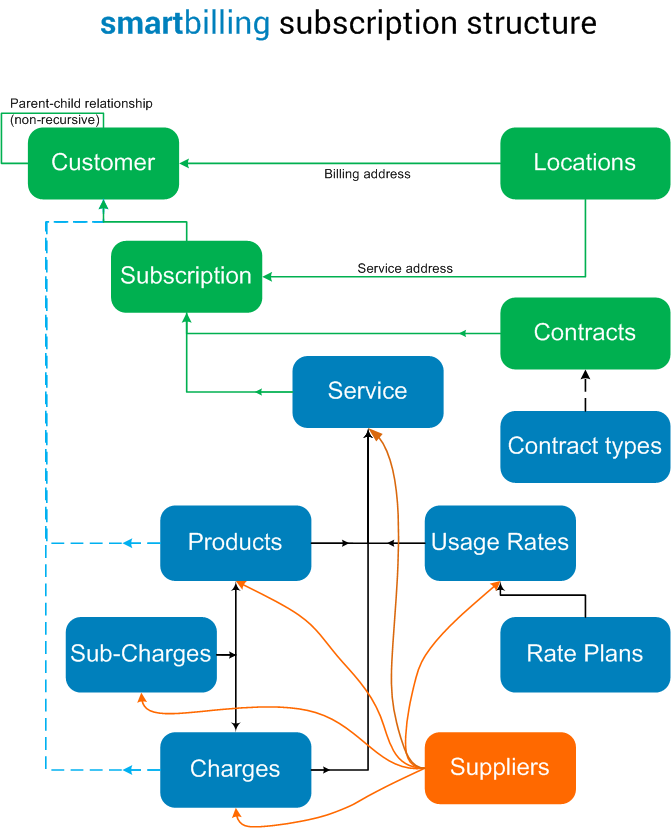When working withsmartbilling, it is important to understand the terminology used by the software. Here is a glossary of smartbilling's terminology.
¶ Catalog
The catalog in smartbilling serves as a central repository that defines the various product and plan-related components used by the smartbilling application to rate charges and generate invocies. It is managed from the Catalog Management user interface page
It encompasses the following objects:
(click on the arrows to expand the descriptions or click on the title links to go to the respective Wiki pages)

1. Services :
Groupings of catalog items offered for sale, allowing the bundling of products, charges, and usage rates into a single offering or plan. A typical service might include, for example, one-time charges for the purchase of equipment, recurring subscription fees grouped with a one-time provisioning charge, an installation fee, and/or one or more usage rates.A service does not inherently contain chargeable items; these must be added to the service as products, charges and/or usage rates.
2. Products :
Tangible or intangible items available for sale that can be carried in inventory. Examples of tangible products include telephone sets, routers, or other hardware items that can be sold, leased or rented to a customer. Intangible products might include things like telephone numbers (DIDs), license keys, or other items to which a customer can subscribe.Products are usually invoiced in association with services (in other words, they are contained within subscriptions), but they can also be configured to be invoiced directly to a customer.
3. Charges:
Catalog items offered for sale that are not carried in inventory. Examples of charges include recurring (monthly, annually, etc.) service fees, incidental fees, or any other type of fee that can be billed to a customer.Charges are usually invoiced in association with services (in other words, they are contained within subscriptions), but they can also be configured to be invoiced directly to a customer.
4. Sub-charges:
Catalog items associated with a parent product or charge catalog item. Sub-charges have the same attributes as charges, but are grouped together with the parent product or charge; for instance, the sale of a product could entail a mandatory or optional delivery/installation/configuration fee, a recurring maintenance fee, or any other one-time or recurring fee linked to the sale of the product. Similarly, a recurring seat license could have one or more mandatory or optional features that are billed separately from the primary parent charge; a hosted PBX license could be linked to an E-911 fee, a voice-mail service, etc.5. Usage Rates:
Catalog items relevant to usage transaction billing. They define classifications into which the individual transactions are grouped, and define the calculation method used to rate usage. Examples include long-distance or mobile calling minutes, periodic (daily, monthly, etc.) counts of licenses or features associated with the subscribed service, electricity or Internet bandwidth consumed between meter readings, etc. Usage Rates cannot be billed directly to a customer. They must be contained within a subscription, and therefore within a service.6. Rate Plans (need to create page):
Rate plans are tables used to determine the rate to be applied based on criteria within the transaction, such as call origin/destination pairings, volume tier levels, or a combination of the two.7. Usage Pools:
Usage Pools allow for multiple subscriptions to share a pool of usage units. For example, there can be a mobile plan offered which pools usage from a shared group of data and minutes for a corporate account paying for multiple mobile subscriptions. ==UPDATE DIAGRAM TO ADD THIS==8. Categories:
Categories are a means of classifying catalog items (products, charges & usage rates) to make data entry more manageable as the catalog grows larger. Categories can be nested up to two levels (parent/child).9. Contract Types:
Contract types define the 'Initial Term' and the 'Renewal Term' of a Contract associated with Subscriptions. The Initial and Renewal Terms of a Contract Type can be specified in intervals of days, months or years.10. Price Lists:
Collections (packages, bundles, groupings) of Services, Products and/or Charges that can be sold by agents or purchased by customers at defined prices within a set validity period. Price Lists can be thought of as ‘editions’ of the Catalog addressed to a specific audience.¶ Subscriptions
A subscription is the instantiation of a catalog service. It is a convenient way to group all of the required parts that must work together to generate invoices for recurring charges, non-recurring charges, and usage charges related to the provision of a particular service to a customer.
While catalog products and charges can be billed directly to customers (dashed blue lines), the only way to invoice usage transactions is through a subscription that contains a usage identifier. (Note the absence of a direct relationship between usage rates and the customer in the diagram below.)

Click here for a more detailed description of a subscription and the objects related to it ...